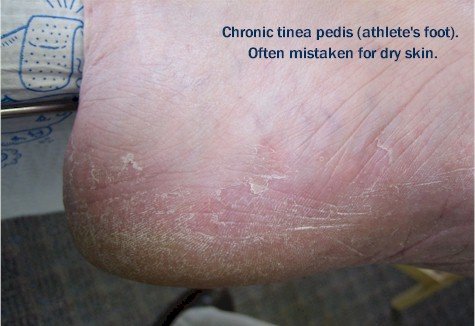If you're over 35 years of age, it's likely that you've come in contact with a low grade fungal infection called tinea rubrum (t. rubrum). t. rubrum looks just like dry skin. Classically described in the dermatology literature, t.rubrum infections appear in a moccasin distribution, meaning to say that the appearance of dry skin, (t. rubrum infection) is distributed on the sides and bottom of the foot.
Dry Skin on the foot? Likely a fungal infection.
If you're over 35 years of age, it's likely that you've come in contact with a low-grade fungal infection called tinea rubrum (t.  rubrum). t. rubrum looks just like dry skin. Classically described in the dermatology literature, t.rubrum infections appear in a moccasin distribution, meaning to say that the appearance of dry skin, (t. rubrum infection) is distributed on the sides and bottom of the foot. In my private office, I hear at least once a day, "that's not just dry skin? No wonder it never responded to skin lotions."
rubrum). t. rubrum looks just like dry skin. Classically described in the dermatology literature, t.rubrum infections appear in a moccasin distribution, meaning to say that the appearance of dry skin, (t. rubrum infection) is distributed on the sides and bottom of the foot. In my private office, I hear at least once a day, "that's not just dry skin? No wonder it never responded to skin lotions."
t. rubrum is one of the two types of fungal foot infections we often refer to as athlete's foot. The classic description of athlete's foot - bubble, blisters, and itching, is caused by another member of the tinea family tinea mentagrophytes. But the more common infection, t. rubrum, is found in most people over 35 years of age.
What causes t. rubrum infections?
- The dark, damp environment inside the shoe
- Wearing shoes that haven't sufficiently dried out
- Exposure to other people with t. rubrum infection
Treatment of t. rubrum infections
There are several points to consider when treating t. rubrum infections. First, treating fungal infections requires an ongoing plan and ongoing treatment. You're not going to cure a t. rubrum infection. And second, create your treatment plan by picking the low hanging fruit. Start by doing the following;
ongoing treatment. You're not going to cure a t. rubrum infection. And second, create your treatment plan by picking the low hanging fruit. Start by doing the following;
- Rotate your shoes allowing them to dry for 24 hour between use
- Wear only shoes that are made with materials that can absorb moisture i.e. leather
- Frequent changes of socks
- Use an antifungal soap on a daily basis
 We carry two products that I recommend that you keep in your shower and use to wash your feet on a daily basis. Natural Antifungal Lavender Tea Tree Bar Soap and Natural Antifungal Lavender Tea Tree Foaming Soap are both antibacterial and antifungal.
We carry two products that I recommend that you keep in your shower and use to wash your feet on a daily basis. Natural Antifungal Lavender Tea Tree Bar Soap and Natural Antifungal Lavender Tea Tree Foaming Soap are both antibacterial and antifungal.
Granted, you cannot cure t. rubrum infections with any medication, over-the-counter or prescription. But you can easily manage these infections with daily use of either of these two products. Take the two-week test and you'll see an obvious difference in the appearance of your feet.
Jeff
Medical Director
Myfootshop.com
Updated 3/16/2021















